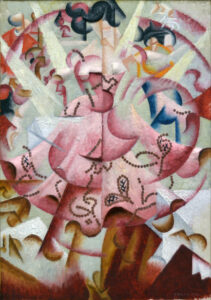
Gino Severini painted Ballerina in Blue or Blue Dancer in oil on canvas in 1912. This painting was created in Paris as a part of a series in which Severini represented cabaret scenes along with the dynamism of dance. The painting is part of the Peggy Guggenheim Collection in Venice.
What is Depicted in the Ballerina in blue (Blue Dancer)?
The painting Ballerina in Blue represents the experience of dancing. In the foreground is the figure of a ballerina in a blue dress dancing gracefully. The figure of a violinist is represented in the upper right corner of the composition. The refined dance movements of the ballerina are represented by the cubist method of scene fragmentation.

Ballerina in blue (Blue Dancer) – Analysis
In the painting Ballerina in blue, Gino Severini gives the traditional theme of the dancer a futurist character. This painting is one of many from the series in which Severini deals with the phenomenon of dance and cabaret scenes. The composition of the painting Ballerina in blue is organized in a simple way with the dancer in the central part and the violinist in the background. Using the mobile perspective, Severini enabled the simultaneity of multiple plans and brought the dynamism of the movement into focus. Cubist fragmentariness enabled the illusion of continuity of movement. It is important to emphasize the importance of the divisionist approach that Severini applied in this painting. Severini positioned the warm tones of red in the central part of the composition, i.e. on the arms and torso of the dancer. Those tones corresponded with the costume of the violinist in the right corner as well as with the ground on which the dancer stands at the very bottom of the painting. The largest part of the composition is occupied by the dancer’s elegant blue dress. Severini achieved the effect of light refraction by combining white, gray, and black fields that surround the pyramidal form of the dancer’s body. In order to improve the refraction of light, Severini also used sequins in the production of this painting.

Related Artworks
In the paintings of Gino Severini, the motif of the dancer was very common. Whether individual figures or collective depictions of dancers, cabaret scenes defined a significant part of Severini’s oeuvre. Some of the related works include the painting Dancer at Pigalle from 1912 and the study Spanish Dancer from 1913.

